There was a good passage of Swallows, House Martins and Meadow Pipits totalling well over a thousand birds moving west along the coast and over the fields at Goring Gap on Monday September 30th on what was one of the calmer mornings of the period. A group of four Wheatears appeared later on the beach there, two of them showing features of the larger ‘Greenland’ race.
Group Meeting – 28th September 2018
Professor Dave Goulson, a biologist and conservationist from Sussex University, who has spent 25 years studying bees and is the founder of the Bumblebee Conservation Trust, educated around 90 members and visitors with a talk entitled ‘Saving our Bumblebees’. Professor Goulson explained that due to large-scale changes to the way the countryside is managed there has been a major decline in bumblebees over the past century. A combination of public demand for cheap food and the mechanisation of agriculture has greatly reduced the density of the flowering plants that bumblebees feed on and left far fewer sheltered areas for them to nest. Some of our rarest species, notably the Great Yellow, now only survive in Scotland and the Scottish Isles.
The only way to boost bumblebee populations and prevent extinctions is to ensure that large areas of farmed countryside are managed sympathetically. Providing even small patches of flower-rich habitat around your garden will make a real difference. To encourage bumblebees into a garden it is important to grow flowers that are useful to bees. Some flower have petals that form long tunnels which are too narrow for bees to feed from while other flowers may not be rich enough in pollen and nectar. If you find a bee on the ground it may be cold through lack of nectar and it is possible to revive it with some sugar water.
Tricia Hall delivered her popular Nature Notes after a break for refreshments by informing the Group that around 100 Swallows and House Martins were seen passing through with some drinking from the Rife on their way, and Meadow Pipits were spotted at the Country Centre. Also nests were found in 10 of the 11 nest boxes sited around the village which makes this project worthwhile.
Ed Miller concluded the meeting with the latest planning news. He advised the Group that Worthing District Council has at last published its Local Plan with Brooklands Park and the northern and southern Goring Gaps all being confirmed as protected open spaces. The detached house proposed at 55, Sea Lane had been approved but the planning application from the Andalucía restaurant for two outside tables and four chairs is still to be decided.
FCG Beach Clean September 2018
Around 30 members of Ferring Conservation Group met by the beach huts to take part in the last beach clean of 2018. Jenny Gritxi, the event organiser, gathered the Group together and explained that the results would count towards, and be submitted to, the Marine Conservation Society’s annual nationwide beach clean. After the necessary health and safety talk hi-vis jackets, black bags and litter pickers were distributed and Jenny directed the helpers to spread out between the stretch of beach between the Bluebird Café and Sea Lane.
Nine year old Lewis Yates was participating as part of his work towards a Blue Peter Badge in Conservation to add to his collection in other categories.
Although few large items of rubbish were found there was still much evidence of small plastic items, many of which were tucked under foliage, pebbles and rocks. The plastic bag charge seems to have had a significant impact from the evidence of this beach clean. Better wet wipe labelling and an awareness of ‘single use’ plastic items will hopefully improve the situation also going forward.
Jenny remarked that a small toy elephant she had found by the shore was similar to others from a consignment of soft toys that were lost at sea when four shipping containers went overboard in rough seas in 2004.
FCG Visit to the Black Rocks at West Kingston
On 13th August, a sunny but windy evening, around 30 members of Ferring Conservation Group met at the Bluebird Café car park for an early evening walk to the Black Rocks at West Kingston. These rocks lay several hundred metres out from the beach and consist of lumps of conglomerate and are only exposed at an exceptionally low tide. They appear black because they are covered by Serrated Wrack (a dark brown seaweed).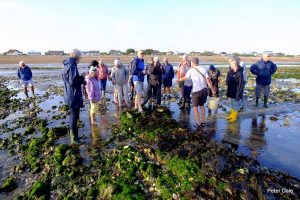
Tricia Hall, the Group’s guide for the evening, made stops along the way to search for as many sea creatures and seaweeds as possible to cross off the list she had provided. Around the Rife outfall area and with the help of two eagle-eyed and very keen children, Tricia soon found some Common Limpets, an Edible Periwinkle, Common Mussels and Dog Whelks. As the Group moved to the middle shore, examples of Sea Lettuce, Gutweed, Spiral Wrack and Cladophora were found along with Irish Moss (sometimes referred to as Carragheen). Many of the three groups of seaweed, green, brown and red are edible and have been eaten in Asian countries for centuries. Seaweed is also used in cosmetics, paint, fertiliser, adhesives, dyes and explosives.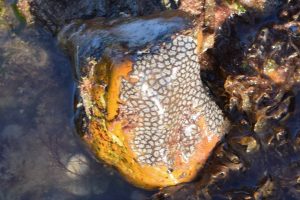
As the Group navigated their way over slippery rocks and pebbles and arrived at the Black Rocks Tricia carefully lifted a small rock from a rock pool, and to the delight of the children found a Broad-Clawed Porcelain Crab, a Squat Lobster and an Orange Jelly Sea Squirt. Graham Tuppen, another keen member of the Group found a delicate Dahlia Anemone, a Beadlet Anemone and Star Ascidian, a jelly-like mass of various colours with tiny star shapes spread over the surface of a small rock.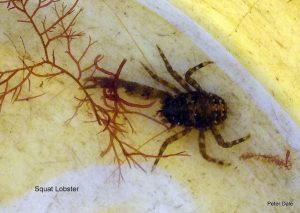
As the sun went down the Group slowly made their way back to Ferring noting evidence of Sand Mason Worms, Spirobis and Keel Worms in the sand and a Sea Squirt that had washed up on the beach. As around ninety per cent of the list had been ticked off members of the Group thanked Tricia and felt that the walk had been an interesting and enjoyable evening.
FCG’s Butterfly Count and Work Party Report
Anybody driving or walking in Sea Lane, Ferring on the last day of July might have wondered why about 20 people were armed with rakes and working hard on the grass verge at the sea end of the road. Well – these were volunteers from Ferring Conservation Group on one of their monthly work parties around the village.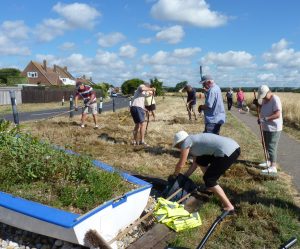
The task this day was to rake up the cut grass and vegetation after the WSCC grass cutters had been there the previous week and had cut down the Summer’s growth in the lower section of the road. The Group in conjunction with Ferring Parish Council are developing this area as a wildflower refuge, and to assist in the process, the cuttings need to be removed to allow the wildflowers to drop seed and hopefully germinate in the next year. If this work isn’t carried out, the seeds can suffocate under a mat of rotting vegetation, which has occurred in previous years, and has led to a reduction in the number and variety of wildflowers including the attractive Salsify.
The proof of the pudding will be next Spring when we hope there will be an improved display in the raked area, and the efforts of our volunteers will have been worth it. We will have to do it all again next year though!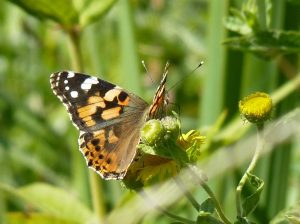
On the following day, a similar sized group of members met on the Ferring Rife to carry out a survey of butterflies around the lagoon area on the west side of the river as part of the national Big Butterfly Count. Although this hot Summer hasn’t been ideal for much of our wildlife, it does seem that butterflies have generally had a good time. The result of our count was a total of 69 butterflies (with 10 different species) in the South Lagoon, and 79 (again with 10 different species) in the North Lagoon.
There were good numbers of the Common Blue, Gatekeeper and Small White, as well as 3 Painted Ladies, and even a rather tatty Silver-Washed Fritillary, which isn’t a common sight away from woodlands. Sadly, there were no Small Tortoiseshells seen, where in the past the Rife area has been a noted stronghold for them. The results were duly forwarded on to the Butterfly Conservation organisation who collate the count nationally.
Group Meeting – 27th July 2018
Fran Southgate, the Living Landscapes Officer from the Sussex Wildlife Trust (SWT), gave an enlightening presentation to Ferring Conservation Group at their recent monthly meeting entitled ‘The Shaping of Landscapes by Water’. Fran conveyed with passion SWT’s quest to greatly improve and protect the county’s wetland areas with a focus on water voles.
Fran explained that although Sussex is the second most wooded county in England it also has wetland areas (where water and land mix and meet) that have some of the richest places for wildlife. These encompass vast areas of low-lying land in places such as the Pevensey Levels and the Arun valley. A combination of good water quality and a network of sensitively managed ditches and the mosaics of wet grassland, reed and scrub mean that large areas of nature friendly wetlands continue to thrive.
This is good news indeed for the water vole that lives along rivers, streams and ditches, around ponds and lakes and in marshes, reedbeds and in areas of wet moorland. These delightful mammals are under threat from habitat loss and predation by the non-native American mink. The water vole is similar-looking to the brown rat, but with a blunt nose, small ears and a furry tail. Water voles are not easy to spot but with a little perseverance their existence can be confirmed at the side of riverbanks, often with a lawn of nibbled grass and stems with a distinctive 45 degree angled-cut at the ends, scattered around the entrance of their burrows. A female will start to breed in spring and can have three to four litters per year of up to five young.
SWT’s vision for the future is to help create living landscapes by enabling wildlife to disperse across areas to find new habitats to increase their distribution, as for many species this is an inherent survival strategy. This can be achieved by encouraging landowners to create green corridors by building grass covered bridges across waterways, planting more hedgerows to make ‘wildlife highways’ and to plant a series of copses or build ponds as stop-off points for wildlife on the move. SWT aims to reverse damage to the landscape by working with natural processes such as re-wilding land, and reverting to natural flood management.
In her regular Nature Notes slot, Tricia Hall reported that many birds and mammals appeared to be struggling locally in the recent hot and dry spell, and were keeping a low profile. However, butterflies seemed to be enjoying things more, with interesting sightings in Ferring gardens of both a Silver-washed Fritillary and a Brown Argus – neither of these are particularly rare as such, but unusual to find them in coastal gardens. The Group will be taking part in the national Big Butterfly Count organised by Butterfly Conservation, as well as organising an evening walk to the Black Rocks, just west of Ferring, on one of the very low tides. Details of all Group events can be found at www.ferringconservationgroup.co.uk
Little Egrets seem to be returning to the village in some numbers from their breeding areas, with up to 12 at a time having been seen in trees on the Ferring Rife as well as at the pond in the south of the village.
Ed Miller gave an update on planning matters, outlining that the Arun Local Plan had been approved, which includes the fact that it obliges Arun District Council to provide 1000 homes per year for the next 15 years across the Arun district. One of the more welcome aspects though is that it provides continuing protection for the local Gaps between settlements, including the Ferring section of Goring Gap. The Group is aware of intentions by Worthing Rugby Club to potentially move their operations to Goring Gap, and the Group has written to the club pointing out that this would conflict with the Local Plan policies and would attract much opposition from residents of Ferring, Goring and the surrounding area.
Group Meeting – 29th June 2018
Ted Green captivated the audience at Ferring Conservation Group’s June meeting by speaking with passion and enthusiasm about his deep knowledge and love of trees. Ted’s professional life began when he was employed as a laboratory technician at Silwood Park, attached to Imperial College, where he had access to the Ancient Woodlands on the nearby Windsor Estate. Here he could pursue his interest in conservation and so accumulating a vast knowledge by observation, experiment and plant trialling. From 1988 to 2003 Ted was the English Nature Conservation Consultant to the Crown Estate at Windsor. He continues as Conservation Consultant there to this day and has been awarded an MBE for his services, and he still works ceaselessly for the protection and greater awareness of our ancient trees.
Ted is credited with bridging any gaps between forestry and conservation and has influenced the debate in forestry and arboriculture for more than 50 years. During his long career, Ted has put forward theories on the importance of managing the whole ecosystem and he has played a major part in encouraging land owners to re-appraise the way they manage their woods and to adopt a more holistic style.
Ted was the founder member of the Ancient Tree Forum in 1993 and has also been involved with the Knepp Rewilding project since its inception in 2001.
After a break for refreshments Tricia Hall presented her welcome Nature Notes slot by telling members of the flora and fauna that was discovered during a recent Group visit to Shoreham Beach. They firstly looked at pioneer species such as Sea Kale, Silver Ragwort and Biting Stonecrop. They also found the blue Viper’s Bugloss, Tree Mallow, red Poppies and the pale pink Sea Daisy. The Group also had glimpses of lizards in the vegetation.
To conclude the meeting Ed Miller advised us of a planning application submitted by WADARS for a cat homing unit on their site at Hangleton Lane, which Ferring Conservation Group intend to support.
Group Meeting – 25th May 2018
Jenny Watkins from British Divers Marine Life Rescue (BDMLR) gave a fascinating, illustrated presentation covering 30 years of Marine Mammal Rescue in the UK. BDMLR was founded in 1988 and is the only charity covering England, Wales and Scotland totally dedicated to the rescue of marine life such as whales, dolphins, porpoises and seals. They are funded entirely by donations.
Jenny explained that BDMLR has its own network of trained volunteer marine mammal medics which respond to calls regarding distressed and stranded marine wildlife 24 hours a day, 365 days a year. They are also called upon by the other emergency services such as HM Coastguard, Fire Brigade, Police, RSPCA and SSPCA and also train their staff.
The BDMLR use a wide range of equipment in their rescues strategically placed throughout the UK to deal with strandings of marine animals, oil spills and fishing gear entanglement. This equipment includes rescue boats, equipment trailers, whale and dolphin pontoon sets, a whale disentanglement kit and regional medic kits with essential supplies.
The BDMLR are keen to train more Marine Mammal Medics and you don’t have to be a diver as people from all walks of life are covered in their medic base. You do need to have a positive attitude and don’t mind being wet and cold and the rest is taught on their Marine Mammal Medic Course. For more information on courses please contact: www.bdmlr.org.uk
Between 1988 and 2018 BDMLR trained 20,000 volunteers and around 18,000 incidents were attended and around 90% were callouts to seals. One of the biggest problems faced is entanglement of wildlife in discarded fishing tackle.
Jenny requested that if you were to find a stranded live sea mammal then to note the place, the state of the tide, and any injuries you can see without getting close and call 01825 765546 during office hours. After 5pm on working days, or at weekends or Bank Holidays call 07787 433412 (this number does not receive texts or pictures).
Nature Notes followed a break for refreshments and this month David Bettiss enlightened us with news of more hedgehog sightings, also that a pair of Stock Doves had taken up residence in the Tawny Owl box in Little Twitten. Many Starlings had been seen locally also Dragonflies and Damselflies around the Rife, the lagoons and Highdown. Twenty wildflower plants had been planted in the Community Orchard including Primrose, Cowslips and Yellow Rattle etc. New herbs had been added to the existing herb bed on the Village Green plus five new trees were recently planted in Little Twitten and Arun DC will be adding several more later this year.
Concluding this month’s meeting Ed Miller kept us up to speed with planning news by advising us that Arun DC had approved the proposed development for 4 x 4 bedroom detached houses at 32 and 34 Sea Lane and also the proposed office block at Hangleton Lane, but the proposed petrol station at ASDA had been refused.
FCG Bluebell Walk 22nd May
Members of Ferring Conservation Group met in French Lane, Patching, to look for Bluebells and other wildlife on the beautiful Angmering Park Estate in the heart of the South Downs National Park. Led by Tricia Hall, the Group’s wildlife expert, we headed off across a public footpath in the direction of the woods. As our walk was later in the year than usual we were not expecting to see vast carpets of Blue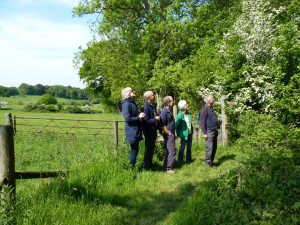 bells but were delighted to find small shady areas where they still stood proud. As we stopped to admire a large Horse Chestnut in bloom Tricia pointed out the pinnate leaves of a young Ash Tree and we also noticed Hazel and Sweet Chestnut trees and several white butterflies. Our walk was made even more enjoyable by a background chorus of bird song which we could identify as Blackbirds, Robins, Chaffinches and Chiffchaffs.
bells but were delighted to find small shady areas where they still stood proud. As we stopped to admire a large Horse Chestnut in bloom Tricia pointed out the pinnate leaves of a young Ash Tree and we also noticed Hazel and Sweet Chestnut trees and several white butterflies. Our walk was made even more enjoyable by a background chorus of bird song which we could identify as Blackbirds, Robins, Chaffinches and Chiffchaffs.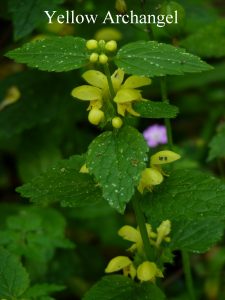
As we headed towards Long Furlong, Red Campion, related to Sea Campion, made an attractive covering along the edge of the footpaths. Woodland Sedge, Ferns, Yellow Archangel nettles and the delicate white flowers of the Sanicle (a member of the carrot family) were also evident. Two Goldilocks Buttercups were found along with White Dead Nettles and the Oxide Daisies were almost in bloom. We were pleased to see Swallows, Skylarks, two Blackcaps, a Green Woodpecker, several Kestrels and also a Buzzard testing the thermals, this time undisturbed by Crows.
Walking alongside a field of Oilseed Rape a Red Kite could be seen high above us and as we took in the view, a glimpse of the sea could be seen in the distance. The pretty, delicate, white flowers of the Hawthorn were at their best; this deciduous tree is native in the UK and made an attractive contrast against the vivid blue sky. Near a patch of the delicate white flowers and fern-like foliage of Cow Parsley we were pleased to see a Holly Blue butterfly and further along the path a Speckled Wood butterfly.
Approaching the end of the path we were brought back to reality as we once again heard the traffic from the main road through Long Furlong, but we were grateful for the opportunity to remind ourselves how fortunate we are to have such glorious countryside on our doorstep.
FCG Beach Clean
Clear skies and warm sunshine greeted over forty members of Ferring Conservation Group when they met at Ferring Beach for the second beach clean of the year. Once kitted out with hi-vis jackets, black sacks and litter pickers the group was addressed by Thomas Kearns, at nine years old one of the youngest members of the Group. As this was Thomas’ first beach clean he asked members if they would be willing to fill in questionnaires at the end of the session as he wanted to conduct his own small survey to better understand the degree of the problem we face in tackling litter on the beach.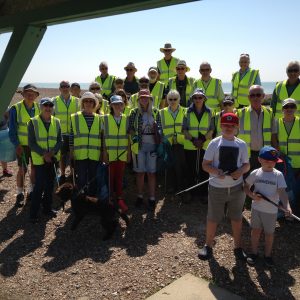
As the members worked across the beach from the Bluebird Café to Sea Lane, including Patterson’s Walk and the area around the beach huts, they were thanked for their efforts by some of the beach users.
The conclusion was that generally the amount of litter collected was less than in previous years but revealed that single-use plastic is still a big problem. After studying the survey questionnaires Thomas said ‘I was surprised at the variety of items found and I will make sure that when my friends visit the beach they take their litter home with them’. The common cause of seabird deaths is marine plastic and leatherback turtles have been found in UK waters with throats tangled with plastic bags that they mistook for jellyfish.
Unfortunately discarded bagged dog faeces were still evident and people seem not to appreciate that this is still regarded in law as litter. In April this year the Government introduced Fixed Penalty Notices for all forms of littering in the UK.
